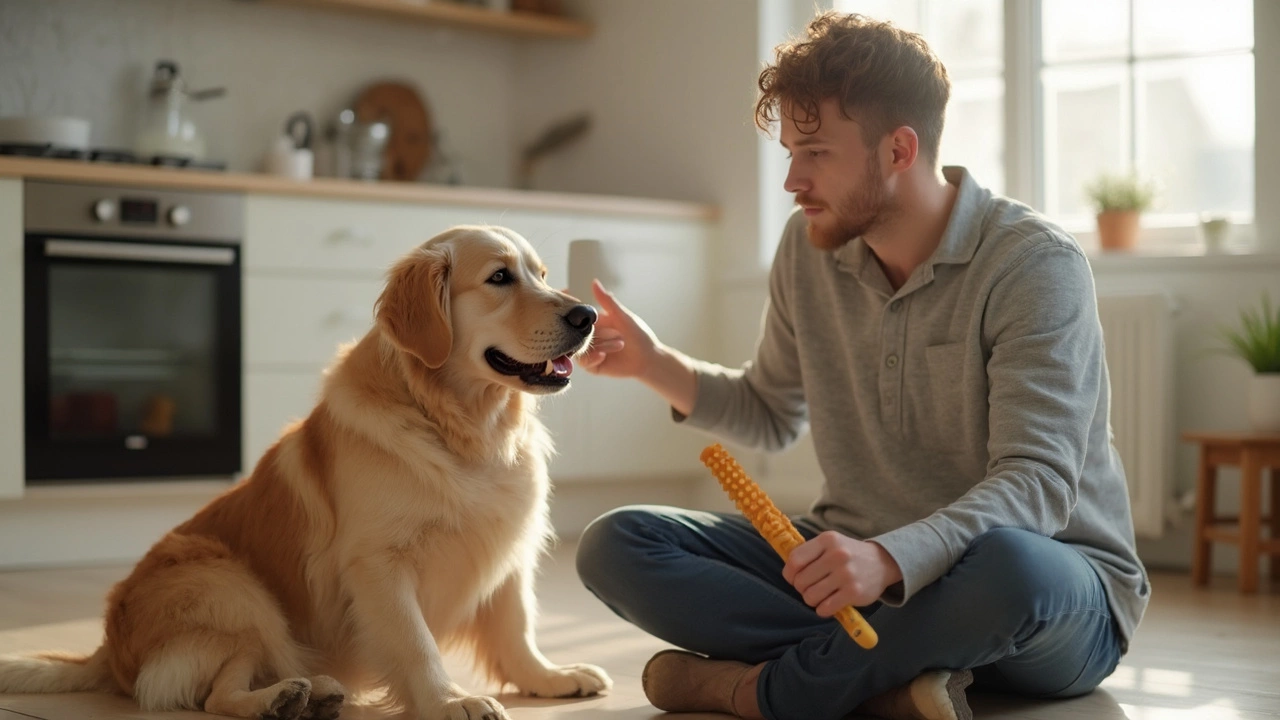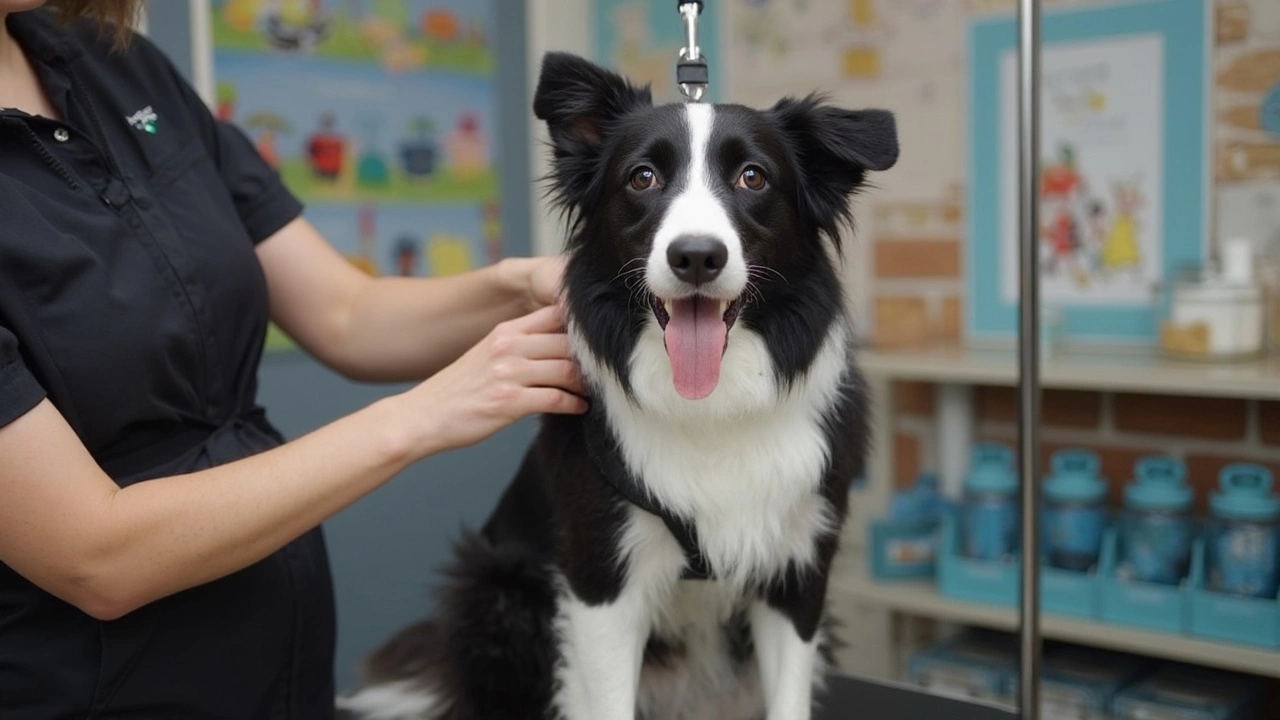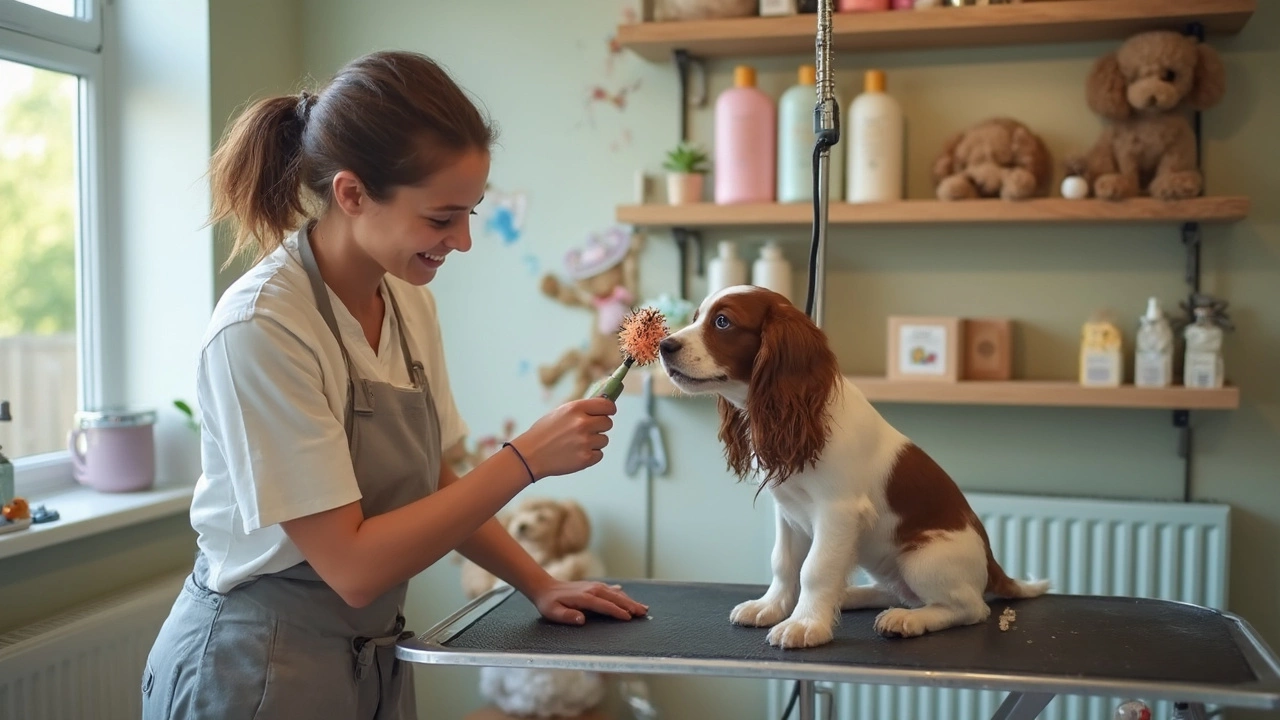If you've ever watched a dog groomer work, you might wonder how on earth they manage to trim squirmy pups or give anxious dogs a tidy haircut without chaos breaking loose. The secret isn't magic—it's a mix of patience, smart tools, and a few clever tricks.
Most dogs aren't fans of standing still, especially with a stranger poking around their ears or feet. Experienced groomers know this, so they set up their space to keep things as stress-free as possible. You'll often see grooming tables with comfy, non-slip mats and special loops (think gentle seatbelts) to keep your furry friend safe but not scared.
But it’s not just about equipment. Groomers also have a knack for spotting signs of nervousness, which means they can work quickly but calmly before a dog gets worked up. Distraction is a big part of the game—think smears of peanut butter on a lick mat, a favorite toy, or even soothing background music. Anything that takes the edge off makes the session smoother.
- The Struggle: Why Dogs Won't Stay Still
- Groomers’ Go-To Tools and Setups
- Simple Tricks to Calm a Shaky Pup
- Teamwork: How Owners Make a Difference
- At-Home Tips for Stress-Free Grooming
The Struggle: Why Dogs Won't Stay Still
If you’ve ever tried to give your dog a bath or trim their nails, you know dogs aren’t big fans of sitting still. Groomers face this all day, but why do dogs act like every grooming session is a trip to the moon?
It really comes down to a mix of instincts, experiences, and plain old nerves. Most dogs are born to move and explore—they’re wired to react to new stuff, especially when it means loud clippers or standing on a table they don’t know. Their noses are bombarded by weird smells, they hear tools buzzing, and there’s often another dog barking in the background. If a dog has had a bad grooming experience in the past, that memory sticks.
Here’s a quick breakdown of why dogs fuss at the groomer:
- Dog grooming involves tools and smells that dogs aren’t used to, so it can be overwhelming.
- Some breeds are naturally more anxious or energetic, like Border Collies or Jack Russells.
- Puppies and dogs that don’t get a lot of handling at home might panic just from having their feet or ears touched.
- Older dogs may have sore joints, making it tough to stand in one spot.
Nail trims are the number one stressor, according to an industry survey in 2023, with 64% of groomers saying dogs squirm the most during nail care. Here’s a look at what dogs typically react to during grooming:
| Trigger | % of Dogs Reacting |
|---|---|
| Nail trimming | 64% |
| Bathing | 52% |
| Ear cleaning | 34% |
| Clippers/Scissors | 28% |
Some dogs never really get used to the process, but a calm, experienced groomer and some patience can make a huge difference. The good news? Dogs who start grooming young and have positive experiences tend to relax more with every visit.
Groomers’ Go-To Tools and Setups
Professional dog groomers never just rely on their hands—the right tools can make the difference between chaos and a calm, safe session. The most obvious piece of gear is the adjustable grooming table. Almost every grooming shop has these because they lift dogs to a comfortable height and give groomers control. The tables also have non-slip mats, so dogs don’t slide around, which instantly helps them feel more secure.
Safety is huge in dog grooming, so you’ll always see a loop or a noose on the table. Don’t worry—these aren’t uncomfortable for dogs. They’re just soft straps that gently guide the dog to stand in place, kind of like a seatbelt. For tricky dogs who really want to spin in circles, double-loop harnesses are used for extra support, keeping both the body and head steady but never too tight.
- Grooming Arms and Restraints: Grooming arms are adjustable metal bars that attach to the table. They hold the loop at the right height, and groomers can adjust these in seconds to suit the dog’s size.
- Lick Mats and Distraction Tools: Some shops stick lick mats right on the table. You smear them with peanut butter or soft treats. Dogs focus on licking, not the buzzing clippers.
- Quiet Clippers and Blowers: Lots of dogs freak out with loud equipment, so groomers invest in low-noise clippers and blowers to cut down on stress.
- Anti-fatigue Mats: These aren’t just for groomers’ feet. Padded mats help dogs stay comfortable during longer sessions, especially older or anxious pups.
Now, check out this quick breakdown of popular grooming gear and what it’s for:
| Tool | Main Purpose | Who Benefits Most |
|---|---|---|
| Grooming Table | Raises dog to height, provides stable surface | All dogs |
| Grooming Loop | Keeps dog steady, prevents jumping | Wiggly, nervous dogs |
| Lick Mat | Distracts, rewards calm | Food-motivated dogs |
| Noiseless Clippers | Reduces fear of sound | Noise-sensitive dogs |
| Anti-fatigue Mat | Comfort during long grooming | Senior or large dogs |
Every groomer tweaks their setup a little based on the breed and the dog’s personality. A wiggly Yorkie might get an extra treat-filled distraction, while a chill Golden Retriever just gets comfy on a big mat. The key is that these tools prevent accidents, make grooming smoother, and keep things as stress-free as possible for both dog and groomer.

Simple Tricks to Calm a Shaky Pup
When a dog starts trembling on the grooming table, groomers know it's time to hit pause and help the dog chill out. It’s all about making the experience positive, not scary. Calming a nervous pup doesn’t always come down to years of training—sometimes the little things make the biggest difference.
One of the most common tricks is introducing a favorite treat or using a lick mat smeared with peanut butter or soft cheese. This distraction keeps their mind busy and turns grooming into snack time. Some pros even freeze the treat on the mat so it lasts through nail trims or brushing sessions.
Touch matters too. Slow petting along the chest or gentle ear rubs can lower a dog's heart rate. Speaking in a steady, upbeat tone helps signal to the dog that everything’s still okay. You might catch a groomer humming or chatting softly—anything to normalize the situation.
Sounds play a role, as well. Many groomers turn on calming music or white noise machines. Studies back this up: relaxing music has been shown to soothe anxious pets, especially classical or reggae. It's a quiet trick but works wonders for dogs who are startled by sudden sounds.
Timing is important. Groomers often schedule nervous dogs for quieter parts of the day, when it's less hectic. Less barking, no loud dryers, fewer distractions.
- Peanut butter or soft treat distractions on lick mats
- Slow, steady petting or gentle massage
- Calm, upbeat chatting or humming
- Calming background music or white noise
- Booking sessions during quiet hours at the shop
All these tricks work together to keep dog grooming chill, safe, and way less stressful. If you have a nervous pup, don’t feel weird about bringing their favorite snack or playlist to the groomer next time—it’s more common than you think.
Teamwork: How Owners Make a Difference
Groomers can work wonders, but the real magic often happens before the appointment even starts. Dogs take a lot of cues from their owners, so your attitude and prep work seriously shape your dog's experience on the grooming table.
First up, regular handling at home makes a huge difference. If your dog is used to having their paws, ears, and muzzle touched during playtime, they're far less likely to freak out during a grooming session. Try these quick routines at home:
- Touch your dog’s feet while giving treats, so nail trims aren’t scary.
- Lift their ears gently and rub them, even if you aren’t cleaning them every time.
- Practice brushing, even when your dog isn’t matted, to make grooming feel normal.
It’s also smart to keep your own nerves in check. If you act anxious, dogs pick up on it and get squirmy themselves. Instead, stay upbeat and calm. Arriving early so your dog can sniff around and settle helps too.
Sharing information with your groomer is another game-changer. Give them a heads-up if your pup is nervous around strangers, terrified of dryers, or gets nippy about their tail. Good groomers want all the details, so don’t be shy.
Last tip: don’t make a big deal of drop-offs and pickups. Quick goodbyes and low-key reunions help prevent stress, making the dog grooming experience smoother for everyone involved.

At-Home Tips for Stress-Free Grooming
You don’t have to be a pro to help your dog chill during grooming. Most dogs learn to handle regular brushing and nail trims at home if you set the right mood and take things slow. If a brush or a pair of clippers makes your pup dart under the couch, don’t freak out—plenty of pet parents start there.
First, make sure you’re working with the right gear. Use brushes and combs that match your dog’s coat type, and keep clippers sharp so they don’t pull at fur. A non-slip mat goes a long way toward keeping your dog stable, especially during baths or trims.
Before you even start, let your dog sniff and check out the tools. Toss a treat or two when they show interest. This can turn dog grooming time from a dreaded chore into something they can actually look forward to. Here’s a simple habit that helps:
- Brush your dog for just a minute or two, then reward them. Gradually make sessions a bit longer over the week.
- Touch their paws and ears gently while you’re just hanging out, so they get used to the feeling.
- Always reward calm behavior with treats or praise. Consistency is key for building good grooming vibes.
“The more positive experiences your dog has with grooming at home, the easier it gets over time,” says Dr. Andrea Tu, a veterinary behaviorist from NYC.
If your dog’s super sensitive, distraction can work wonders. Try smearing a little peanut butter on a lick mat or giving your dog a tasty chew while brushing. These simple hacks keep their mind off the scary stuff.
Some owners find that grooming right after exercise makes a difference—a tired dog is less likely to squirm. And if things go south, keep sessions short and quit while you’re ahead. No point dragging it out if everyone’s frustrated.
Curious about what works best for most dogs? Check out the numbers:
| Grooming Routine | Percentage of Owners With Calmer Dogs |
|---|---|
| Short, daily brushing sessions | 72% |
| Treats/distraction used | 68% |
| Grooming post-exercise | 55% |
| Forceful or fast sessions | 12% |
Keep it simple: patience, good snacks, and the right setup. That’s the real secret to stress-free home grooming.
